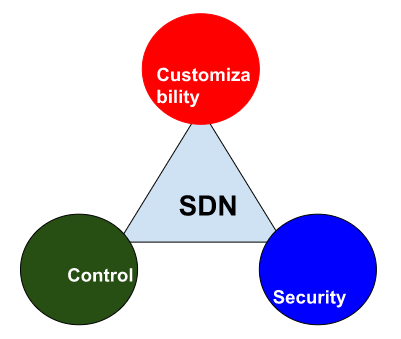The Software Defined Network or SDN market was worth USD 13.7 billion in 2020; by 2025, the market value may increase to USD 32.7 billion. According to marketsandmarkets.com, the SDN market will have a CAGR of 19.0%. The growth has the following characteristics:
- Digitalization attempts by India, China, and Southeast Asia drive the primary growth in the Asian SDN market.
- Investment by the Communications Services Providers(CSPs) significantly contributes to this SDN market growth.
- Most of the global market share will be due to North American companies.
- The next five years will show increased opportunities for the stakeholders due to new products and expansion.
So it is clear that Software Defined Networks (SDN) continue to grab the attention of stakeholders. Read on to learn what an SDN is, its benefits, and the best practices for creating a robust Next Generation SDN.
Contents
What is SDN?
Software-Defined Networking (SDN) communicates with hardware infrastructure using APIs or software controllers, replacing the functions of a router, switch, etc. An SDN offers a new method of routing information and creating a virtual network; it creates agile and flexible networks by making network configuration programmable. SDN aims to implement automated provisioning and management.
Benefits of SDN
Increased Control
You can avoid vendor lock-in; developers can code custom network definitions. Moreover, developers can define the protocols for hardware interactions. Therefore, programmers can use any hardware and implement appropriate protocols.

Real-time Customizability
Real-time customizability is another feature of SDDM. You can use custom scripts to change configurations immediately with minimum downtime. This simplifies resource administration, as developers can deploy configurations for a single point of contact.
Increased Security
You monitor and analyze your entire network seamlessly in an SDN and security zones as required. With separate zones for devices, you can immediately isolate threats upon detection; this eliminates the lateral movements of the intruder.
Operation of an SDN
SDN disaggregates software from the hardware; traditionally, the hardware controls where to send data in addition to transmitting the data. However, software controls the data destination in an SDN, leaving only the actual transmission to the hardware. So you can build a robust, next-generation software-defined network from a single workstation. Otherwise, you have to configure the network for every device.
Parts of SDN:
- Applications
- Controllers
- Networking Devices
The applications handle the resource requests, controllers manage the data flow, and networking devices send and receive data.
An SDN is crucial for cloud operations, as you need robust virtualization for cloud computing. Moreover, cloud companies have data centers worldwide that connect over a software-defined network, enabling smooth communication between multiple data centers.
Telecoms use SDN for virtualizing their RAN services; NFV or Network Functions Virtualizations allow telcos to virtually run their RAN architecture on a standard cloud. This process makes them independent of proprietary hardware and makes network expansions more straightforward.
SDN also operates behind emerging technologies, including edge computing and the internet of things. These new-gen techs need speeds and flexibility only a software-defined network can provide.
| Software-Defined Network | Traditional Network |
| Software-based | Hardware-based |
| Flexible | Difficult to change the configuration |
| Customizable Infrastructure | Tedious to customize the infrastructure |
| Vendor Agnostic | Hardware compatibility problems |
| Easy to set-up | Requires configuration for each device separately |
| Ability to implement holistic security features | More complicated to secure individual devices |
Crucial things to keep in mind while building an SDN
All these features may tempt you to convert your existing traditional network to an SDN; however, you must consider the following points before beginning this project.
Does your Enterprise need an SDN?
The primary quality of SDN is its adaptability to change; you can alter network configuration from a single window. That means you don’t have to access each device separately and ensure the correct configuration. So if your organization’s network frequently changes, you might benefit from SDN.
Study use cases of organizations who have adopted SDN networks
You can get information about popular organizations shifting their networks from traditional to SDN. Understanding them may tell you about the challenges involving such migration.
Train your IT
Skills for operating SDNs differ from those for operating traditional networks, and several training institutions exist worldwide for training your employees in that skill set. Skilled IT staff will have better productivity, generating a higher ROI.
Understand your network assets
Make a database containing all your network resources, which can be challenging depending on the network’s size and type. However, understanding network assets will ensure a smooth migration from traditional networks to SDN.
Start with a Small-Scale Implementation
You can’t build a robust software-defined network without testing for all the possible failures. Start small by only migrating a single domain or service; keep documenting your procedures for future reference, and slowly transform the entire network into an SDN.
The points mentioned above are crucial and require expertise and experience to implement. You can hire any of the popular SDN services to create agile, secure, and scalable software-defined networks; network services may include SDN consulting, building SDN centers, Implementing SD-WAN, etc.
Takeaway
Software-defined networks are more efficient than traditional ones because of their ability to adapt to network changes quickly, the opportunity for global security policies, and smooth data transfer between remote servers. However, building a next-generation, robust SDN takes hard work, patience, expertise, and experience. After deciding that your company needs an SDN, start understanding your company’s networks; build a database of your network resources. Then, start training your IT staff to use SDN technology to operate efficiently. These tasks are tedious; however, you can get help from various SDN service providers to efficiently set up a software-defined network. The SDN market, including SDN services, is a rapidly growing industry, and its major stakeholders are telcos worldwide. That is because the telecom industry understands the value of the efficient network an SDN offers.














